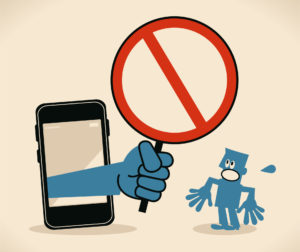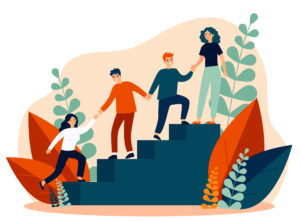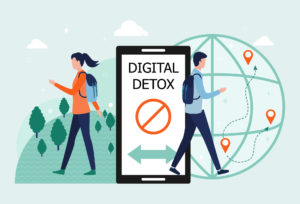Dangers of Social Media: In just over a decade, social media has taken the world by storm. For better and worse, this online world has become integrated into our physical and mental worlds. Today we explore the pitfalls of social media and ways to nurture a healthy relationship with it and yourself.

This article has been medically reviewed by Dr. Charles Penick, MD
Doomscrolling
Have you ever caught yourself in a rabbit hole of mindless scrolling along with a newsfeed, catching yourself 10, 20, or maybe 60 minutes later, almost in a daze? Well, you’re not alone. This act of consuming a seemingly endless amount of, often negative, content on social media has been called ‘doomscrolling.’ Although social media is somewhat of an artificial world, the dangers of social media and its impact on mental and physical health are real.
One study highlights that 20 minutes alone on Facebook contributed to lowered moods, compared to a control group who spent the same amount of time merely browsing the internet.1 More social media use was also linked to greater odds of having an anxiety disorder, including chronic anxiety, depression, suicidality, loneliness, and decreased empathy.2
A big part of the ‘doomscrolling’ concept lies in ingesting harmful content. One of the dangers of social media is a constant bombardment with bad or scary news can lead to something called mean world syndrome. This syndrome is caused by heavy and chronic exposure to violence-related content from media sources. It can cause people to perceive the world as more dangerous than it is, perpetuating anxiety, depression, and a general navigating of life in fear.3
Our tendency as humans to be drawn to negative information is rooted in survival. Our ancestors only had access to their immediate surroundings, and knowing dangerous, scary, or threatening events was critical. We needed to know what to avoid to stay alive. Today, our social media exposure to information from around the whole world puts our brains into fight or flight in a situation where for the most part, the threats are not imminent to us, nor do we have much power to influence the situation. This is one of the dangers of social media that puts our psyche in a lose-lose situation.
Living in a fearful, anxious, or depressed state severely affects mental health. Social media promotes mental distress in many other ways, including the anxiety that comes from having to come across as ‘perfect’ or even having to match the image you’ve created for yourself online but in real life. People can filter themselves, get the best angles, and even edit the photos they post on social media, which creates, for many, a fear of being seen out in the real world.
We get so comfortable curating our lives from behind a screen that many people lose the confidence to connect with people face to face—having to speak without thinking ahead of time about what to type can create crippling anxiety.
How to Protect Your Mental Health with Social Media
It would be easy to say, ‘get off of social media altogether.’ In reality, many of us genuinely use social media, and when used mindfully, it can significantly enhance our quality of life. From social connections to work opportunities, entertainment, and education: there are many benefits to using these platforms. Here are some tips for cultivating a healthy relationship that promotes mental health while using social media.
1. Filter Your Exposure

Filtering the content you expose yourself to can make a huge difference in generating negative mental health effects. Unfollow and unfriend accounts that promote negative self-talk or destress inside of you. Luckily, most social media platforms allow you to “hide” accounts without necessarily unfollowing them. That way, you can avoid conflict from unfriending someone and also avoid over-exposing yourself to the constant bombardment of negative content some of them may post.
Try ‘cleansing’ the accounts you regularly follow, perhaps once a month or once a season. As you evolve as a person, you may find that some accounts simply aren’t serving your mental health anymore. Opt to “friend” and “follow” individuals who uplift, inspire, and support your well-being.
A study out of UC San Diego demonstrates that negativity and positivity are contagious on social media. In fact, positivity seems to come up on top, with negative posts perpetuating negative posts by 1.3%, while positive posts perpetuating other positive posts by 1.75%.4 The translation into real-life positive change, though, remains to be seen.
2. Cultivate Community

One of the positive aspects of social media is the ability to connect with people that are outside our immediate geography. This is especially important for people who live in more remote areas or may even have a degree of social anxiety. The ability to make meaningful connections with people online, with people who share similar (perhaps quirky) interests, allows us to feel support.
There are online groups and communities in various places and for just about every interest or hobby. It can be great to connect with people in the realm of health, for example, and get answers to subjects based on the many perspectives of people worldwide. Many groups also give individuals access to knowledge, who often share an abundance of free information on these platforms.
3. Connect the Dots in Real Life

Although social media can offer a sense of community, one crucial part of mental health and cultivating a healthy relationship with the online world is not to forgo real-life connections. Keep track of how much time you spend online, and continuously connect with people in real life.
Many people are capable of turning online connections into real-life connections as well. It’s always important to be cautious when meeting people from an online contact, but these relationships can indeed blossom into a real community. Although the online world is a great starting place, it should not completely trump real-life interaction. Balance!
4. Take Breaks (Digital Detox) and Boundaries

One way to mitigate some of the dangers of social media? It can be useful to set boundaries with social media and take regular ‘digital detoxes’ from all forms of social media platforms. Boundaries could look like not using your phone while spending time with the family, during meals, or in the bedroom. Setting a circadian-based time limit (like not using the phone between 8 pm and 7 am) is great for your mental and physical health (avoiding blue light after sundown is ideal).
Dangers of Social Media: The Physical Toll

By now, the mental health toll that social media can take should be evident. But what about the physical toll? Yep, spending too much time in front of a screen can indeed also harm your physical health.
1. Posture and Biomechanics
The way we position ourselves around technology is anything but natural. Whether we sit upright on a chair, without moving for hours at a desktop computer, or lay awkwardly on the bed, neck cranked up, on our laptops: humans are designed for natural movement that does not require being stagnant and staring into a screen for hours.
Common injuries that result from too much time on devices include:5
- Posterior cervical dorsal syndrome (“computer back”)
- “Mouse shoulder”
- Carpal tunnel syndrome
- Tennis elbow
- Lumbar sprains and strains
- Disc injuries
The solution: keep moving in natural positions. Try sitting on the ground at a short test, spend some time at a stand-up desk, then sit on a bouncy ball, take regular breaks to go for a walk, shake it out, and spend time outside. Find ways to work away from technology when possible: consider taking phone call meetings while walking in the park, for example.
2. Blue Light Exposure and Sleep
We scroll social media on screens that emit blue light. This artificial light that comes from electronics (including lightbulbs and more) tricks our bodies into thinking it’s daytime. This is an artificial kind of light our bodies are naturally used to seeing only during the day.
This becomes especially problematic after sundown when we usually should start winding down for sleep. After sundown, the body starts to produce melatonin (the sleep hormone), but this natural process is interrupted when blue light is present. Instead of melatonin, the body continues to pump cortisol and other hormones that keep you awake. [6]
The solution: use red filters on your devices, wear blue light-blocking glasses, and ideally stop using all technology that emits blue light after sundown or at least 2 hours before bed.
3. EMF Exposure
Electromagnetic frequencies are harmful to human health. These artificially generated frequencies interrupt our body’s natural electromagnetic fields and can cause various ailments and symptoms, such as insomnia, migraines, and cancer.7
The solution: keep at least 1 foot away from electronic devices at all times, whenever possible. Turn off the wi-fi at night, and opt for ethernet (plug-in) internet if possible. Never use your cell phone directly to your ear; instead, use headphones that plugin. Keep all electronics out of the bedroom. Avoid smart meters/ any devices that use “smart” technology. Use shielding devices between you and your laptops and special EMF-blocking cases on your cell phone. Avoid any technology with Bluetooth, and always keep your Bluetooth turned off on your cellphone.
4. Exposing Hands and Face to Nasty Germs
Many phones carry more germs than toilet seats. This should make you think twice before scrolling while you eat lunch! We touch our phones all day long and don’t hesitate to bring them up to our faces to answer a phone call.
The solution is to avoid speaking face to face; use earphones or a headset instead. Clean your phone regularly, as well as your hands, after touching your phone. Keep your phone in a case/ pouch to avoid laying it directly on public surfaces like tables and bathrooms.
Summary
The overuse of social media, especially chronic exposure to negative content, has been called doomscrolling. Although this habit occurs in a virtual world, our physical and mental health impacts are very real. Studies highlight the increased anxiety, depression, and loneliness that spending too much time on social media can cause. It also gives rise to mean world syndrome, whereby individuals believe the world is a more hostile place than it actually is.
Physically, too much time using social media technology can harm our posture and biomechanics, it can interrupt sleep quality and health due to blue light and EMF exposure. It can expose us to bacteria, germs, and viruses due to the dirty nature of cellphones.
Social media can have some very real benefits when used mindfully. But we must be cognizant of the dangers of social media. Some tips to increase a healthy relationship with social media includes filtering your exposure to negative content, creating a community, turning that community into real-life relationships, and taking regular digital detoxes (breaks) from social media.
Mitigate EMFs with Lambs
Besides nutrition, EMF mitigation might be the most important health hack to invest in. EMFs can affect your nervous system, causing cell damage and triggering painful, life-long symptoms from sleep disturbances to headaches, nausea, and depression.
But most EMF mitigation tools are hundreds, if not thousands of dollars… Until now.
Inspired by NASA space suits, this collection of comfortable clothing and headwear blocks wireless radiation —all while looking and feeling incredible.
The Faraday line offers:
- 99% protection from EMFs caused by WiFi, Bluetooth, and cellphone radiation
- Anti-odor and antimicrobial properties to eliminate smells and harmful bacteria
- Lightweight, breathable, and wrinkle-resistant—perfect for everyday wear
- Breathable, heat-regulating cloth that diffuses heat for maximum comfort
The Faraday line from Lamb is a no-brainer for everyday EMF protection and comfort.
>> Explore the line and keep the “bad” off your goods!
Medical Disclaimer: This article is based on the opinions of The Cell Health team. The information on this website is not intended to replace a one-on-one relationship with a qualified healthcare professional and is not intended as medical advice. It is intended to share knowledge and information from the research and experience of the Cell Health team. This article has been medically reviewed by Dr. Charles Penick, MD, for the accuracy of the information provided. Still, we encourage you to make your own healthcare decisions based on your research and in partnership with a qualified healthcare professional.
References
- Sagioglou, Christina, and Tobias Greitemeyer. “Facebook’s Emotional Consequences: Why Facebook Causes a Decrease in Mood and Why People Still Use It.” Computers in Human Behavior, vol. 35, 2014, pp. 359–363., doi:10.1016/j.chb.2014.03.003.
- Berryman, Chloe, et al. “Social Media Use and Mental Health among Young Adults.” Psychiatric Quarterly, vol. 89, no. 2, 2017, pp. 307–314., doi:10.1007/s11126-017-9535-6.
- Gao, Junling, et al. “Mental Health Problems, and Social Media Exposure during COVID-19 Outbreak.” Plos One, vol. 15, no. 4, 2020, doi:10.1371/journal.pone.0231924.
- Coviello, Lorenzo, et al. “Detecting Emotional Contagion in Massive Social Networks.” PLoS ONE, vol. 9, no. 3, 2014, doi:10.1371/journal.pone.0090315.
- Bowman, Katy, and Jillian Nicol. Movement Matters: Essays on: Movement Science, Movement Ecology and the Nature of Movement. Lotus Publishing, 2016.
- Hatori, M., Gronfier, C., Van Gelder, R.N. et al. Global rise of potential health hazards caused by blue light-induced circadian disruption in modern aging societies. npj Aging Mech Dis3, 9 (2017). https://doi.org/10.1038/s41514-017-0010-2
- Carpenter, David O. “Electromagnetic Fields and Cancer: The Cost of Doing Nothing.” REVIEWS ON ENVIRONMENTAL HEALTH, vol. 25, no. 1, 27 Jan. 2009. University of Albany, www.researchgate.net/profile/David_Carpenter2/publication/43353127_Electromagnetic_Fields_and_Cancer_The_Cost_of_Doing_Nothing/links/0fcfd51014208cc7a9000000.pdf.


